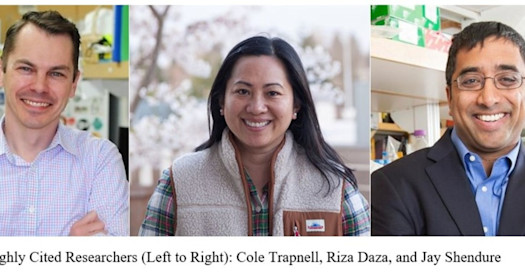 Dr. Elizabeth Blue: 'We need more refined tools to help people understand their risk. We’re not there yet, but we are getting there.'
Dr. Elizabeth Blue: 'We need more refined tools to help people understand their risk. We’re not there yet, but we are getting there.'
BBI: Please tell us about your journey to science and your area of research.
Dr. Blue: As an undergraduate, I had originally planned on studying political science. After completing a core requirement in biological anthropology, I fell in love with the idea that the body contains information about the past, present, and future. Looking at someone’s teeth or foot bones, we can see evidence of ancestry, that person’s occupation, or of diseases they might have had. With genetics, we can look backward in time by looking at patterns of identity by descent, and see the path our DNA took over time. Similarly, we are entering a time where we can look at genetic variants in our DNA as predictors of diseases we might face.
I went to University of Utah and completed a PhD in anthropology focused on population genetics, working closely with Drs. Alan Rogers, Lynn Jorde, and Dennis O’Rourke. I learned modern DNA techniques, but also ancient DNA techniques and how to use DNA to tease out the history of ancient peoples. I was motivated to use these skills to help people today. Dr. Ellen Wijsman at UW took me on as a postdoc, and I learned statistical genetics from her. This process married my prior training in population genetics to using things like family studies and Genome Wide Association Studies (GWAS) to implicate specific genetic variants in disease risk.
BBI: This is a fascinating fusion of anthropology to modern genetic techniques. Could you tell us about an example in your recent work that exemplifies this?
Dr. Blue: Big picture, Alzheimer’s Disease (AD) is a complex trait. It is very common, as the sixth most common cause of death in the U.S. and is characterized by accumulations of proteins in and outside of neurons that cause cell death and dementia. Age and family history are the biggest risk factors for the disease. There are some rare variants in genes that cause early onset disease, but these only encompass a slim portion of all cases.
With respect to the common genetic variants that modify AD risk, APOE is the major gene. There is a protective allele of APOE called ε2, and there is a deleterious allele called ε4 that makes developing Alzheimer’s Disease more likely. These two alleles are defined by two missense variants, amino acid substitutions in APOE that alter protein function. Interestingly, there is evidence that having an ε4 allele is more deleterious for those who have European or Asian ancestry, and less dangerous for those who have an ε4 allele that is of African ancestry. There is a difference in estimated effect based on ancestry for the same missense mutation causing the exact same change in the gene’s protein structure.
BBI: Interesting, how did you go about understanding what might be causing the difference in risk for the exact same mutations APOE?
Dr. Blue: From a genetic standpoint, there are two possible explanations for the differences in estimated effect based on genetic ancestry. It could be that there are other variants across the genome that interact with the APOE gene, thus impacting risk, with very different frequencies across populations. Alternatively, there could be ancestry-specific variation that is inherited with the ε2 and ε4 variants that influences their function. For example, there could be neighboring non-coding variants that affect gene regulation (of APOE and/or a neighboring gene) in a way that impacts disease.
How can we distinguish the effects of genetic modifiers that are background variation, living elsewhere on the genome, versus things that are physically being inherited along with APOE? To do this, we focused on a data set representing Caribbean Hispanics, participants largely from the Dominican Republic, that was rich in family data. Caribbean Hispanics have a history of admixture, and have ancestors representing African, Native American, and European genomes. It is important to recognize that genetic variation is shared among populations, and that people classified as belonging to one group can have genetic variants that are more common elsewhere. For example, African-derived alleles are found in European individuals and vice versa and both were present in this dataset.
Surprisingly, we found that people who inherited their APOE alleles from African ancestors had 39 percent less risk of Alzheimer’s disease than those who inherited their APOE alleles from European ancestors. We also saw that the odds ratio (OR) comparing AD risk for those homozygous for ε4 vs. the reference allele ε3 was also nearly three times higher for European American participants (OR = 15.89), than Caribbean Hispanics with European-derived APOE alleles (OR = 5.60).
This all suggests that there is variation at the APOE locus that varies in frequency between African and European haplotypes that is associated with AD risk, along with genetic variation elsewhere and environmental factors.
BBI: What are the next steps to understand what might be happening at that locus that varies by haplotype ancestry?
Dr. Blue: We want to know which groups of variants are driving this signal. So far, the results are exciting! Others have shown that there are differences in APOE expression in the brains of individuals with the same APOE genotype depending on whether they have a European or African-derived haplotype. This suggests the effect somehow influences APOE regulation. To investigate this local ancestry signal, next steps will require a mix of more statistics, bioinformatics, and eventually bench work in the lab to find out if our computationally prioritized variants in fact influence expression.
With respect to Alzheimer’s Disease today, because ε2 and ε4 are such strong predictors of risk, people are using them as a genetic test for disease risk right now. Chris Helmsworth has publicly discussed finding out he is homozygous for the ε4 allele, and is taking a break from acting to spend time with his family. This is breaking out into commercial use as well. But this research clearly shows the reality is more complicated. Even though ε4 is a predictor of disease risk in the population, that disease risk is modified substantially depending on if you inherited a European haplotype or not. Something is happening at this locus that is modifying risk in a big way depending on a heritable difference at the APOE locus. If I have an ε4 allele, I would really want to know if that allele is on an African background, because it substantially modifies my risk. Because this is breaking out into the mainstream, we need more refined tools to help people understand their risk. We’re not there yet, but we are getting there.


